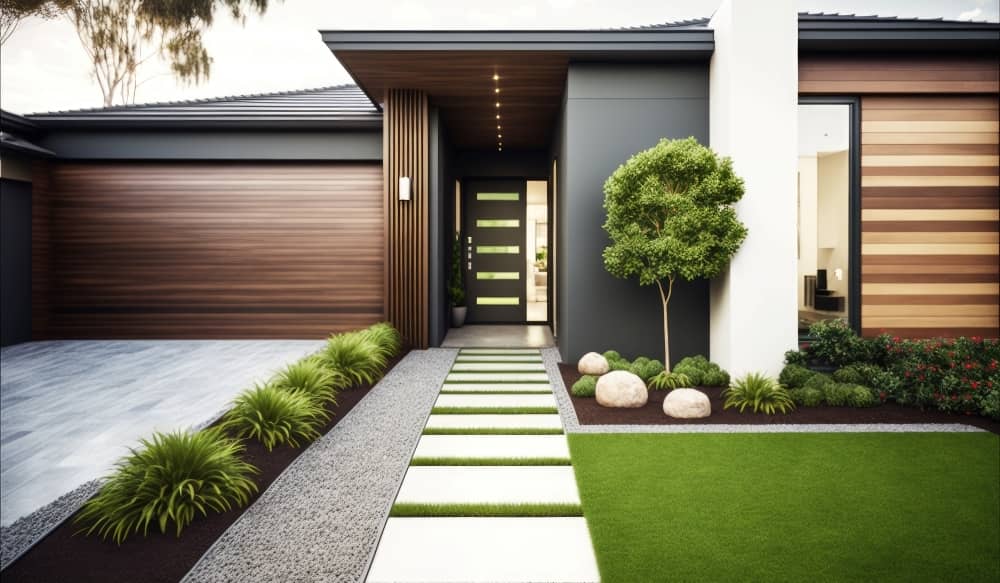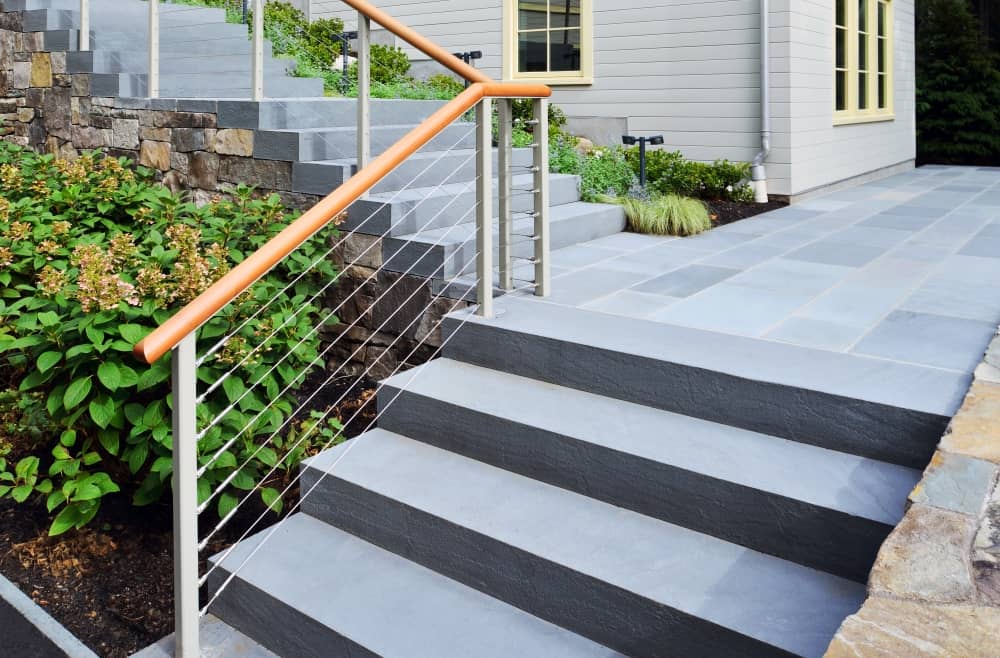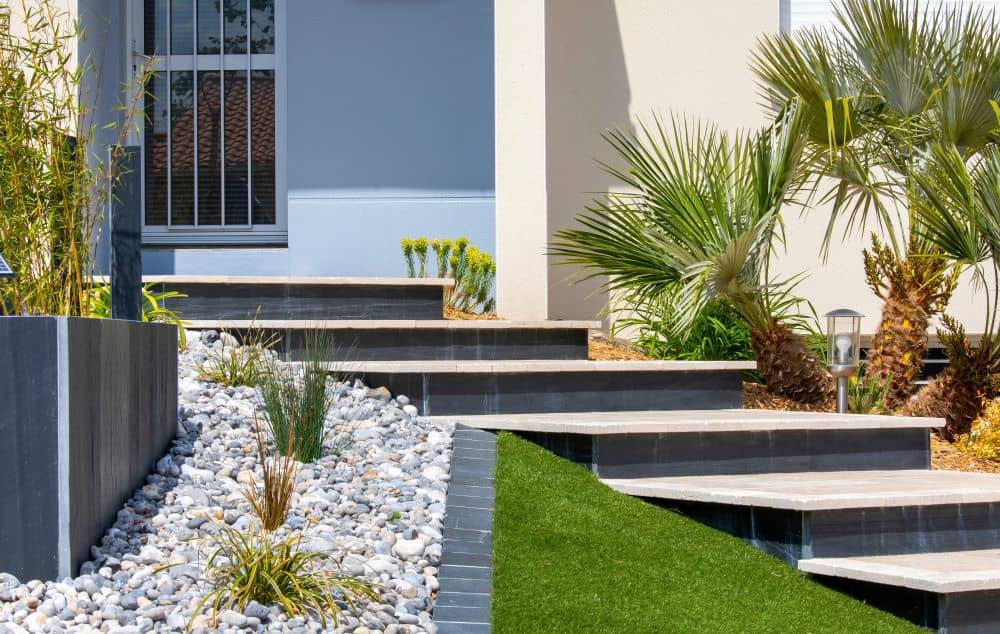Concrete steps, sometimes known as terraced stairways, have always been seen as a practical part of a home’s entryway. They are also poured along with walkways to help transition the elevations. Many entryways showcase this common theme to portray a more cohesive visual effect.
Concrete steps are generally used for utilitarian reasons. However, thanks to technology, concrete stairs have become more elegant and stylish, giving any front entrance a dramatic spotlight.
Concrete steps can be constructed in two different ways:
- Precast or steps built in a factory and delivered directly to the construction site where they will be installed
- Poured or custom-made concrete steps that a form to be constructed onsite
Precast concrete is extremely convenient. The steps are immediately ready once installed. Meanwhile, pouring concrete is quite time-consuming. However, the steps are more versatile since you can build them to fit the requirements of the specific site. For example, poured concrete steps can have landings, along with varying widths and thicknesses.
Concrete steps can be designed in many ways, but the most typical are:
- Suspended, meaning the stairs hang above the ground
- Earth-Supported is a common design for poured concrete where the slab reaches the ground for more support
Whichever type and design of concrete steps you choose, the benefits remain the same. Here are great reasons why you may want to go for concrete as the material for your entryway’s steps:
1. Quick and Easy Installation
Prefabricated or precast concrete can be installed quickly, ensuring that the steps are ready for immediate use. They can even be installed during the construction phase and usually do not require protection.
2. Install Anytime
Sure, you cannot pour concrete when it is raining, especially if you’re working on outdoor steps. Water can affect the formula of the material, which can then result in a weaker set of steps. If the problem is not corrected right away, the installed stairs will crumble quickly.
However, that is not an issue with precast concrete. You can install the steps anytime, even during wet seasons. Precast is manufactured under controlled conditions. Plus, the steps are already set and ready for installation, no matter the weather.
3. Affordable
Precast can be a little expensive, but you can opt for poured concrete instead. It does cost time because you have to pour the material manually and wait for it to cure. However, it is much cheaper whilst affording you the benefit of versatility, as well.
4. Design
Numerous designs are available for concrete steps. If you have an industrial scheme, you can go for the “naked” look. But many homeowners want to dress their steps by adding staining, integral colouring, or dry-shake colour hardeners. These techniques can be combined to generate unique variations, including marbling effects.
For ideas, you can pick a stamped concrete pattern, such as slate, brick, or even botanical styles. You can also expose the aggregate, which produces spectacular effects. Another option is to replicate the beauty of a natural cut stone. No matter what you desire, concrete steps are incredibly flexible in terms of style, giving expensive materials a run for their money. You can even match your preferred style with these outdoor design ideas to further improve your home’s appeal.
5. Stable
Concrete resistance is high, which is an essential trait for entryway steps. It has been proven time and again that there’s hardly any damage on the steps, even after many years of use. Concrete staircases rarely require repair, especially when maintained carefully.
6. Maintenance
Concrete is durable, making it one of the best materials for a busy walkway. However, just like anything else, it also requires a little bit of TLC from time to time. Don’t worry; concrete step maintenance is super easy with these quick tips:
-
- Remove everyday dirt and grime at least once a year with a broom.
- You can use an acid-based cleaner to dissolve rust. Some cleaners that you can use include lemon juice, vinegar, or any product that has trisodium phosphate or oxalic acid.
- Other stains can easily be removed by pressure washing and using common detergents.
- Seal the concrete joints to reduce water intrusion and dirt collection.
- If you see any weeds sprouting, immediately remove them.
Sealing concrete stairs is probably the most important part of maintenance. It helps repel water and dust whilst resisting abrasion and UV sunlight, making the steps look new and beautiful for longer.
7. Safety
When poured or installed professionally, you should have no issues with your stairs’ safety. Tripping is probably the biggest issue with concrete steps or any steps for that matter. At CoastCrete, we can lay concrete steps that guarantee uniformity in all treads and risers. That way, there is a lower risk of accidents, thanks to the application of the best riser height and tread width.
In some cases, it helps to enhance the steps visually, which can be done by using contrasting patterns or colours. This method is effective in preventing missteps, especially for the visually impaired. Generally, this works well with round nosing and distinct edges to enhance safety.
8. Fire-Resistance
Did you know that concrete offers the best fire resistance out of any construction material? Unlike wood, concrete will not burn and cannot be set on fire. It does not emit toxic fumes, including smoke and will not drip molten particles. That’s why it is an excellent option for homeowners with allergies and asthma.
Using concrete for your stairs gives you a high level of protection. Some studies show that it can offer up to four hours of fire resistance, providing you and your home with an effective shield in such an emergency.
9. Eco-Friendly
Concrete has a lesser impact on the planet, especially the precast type. It is a green option that conserves resources mainly because the material uses lower amounts of concrete mixtures. Additionally, precast concrete is hollow, so it’s easier and faster to transport.
Many manufacturers also utilise recycled materials to lessen their carbon footprint. With minimised construction time, fewer resources are used, as well.
10. High Performance
Concrete, whether you have precast or poured, is ideal for any climate. Perth summers can be extremely hot, but concrete will not cave into the high temperatures. The material will not decompose, which is a huge problem with other natural materials, especially wood. You also do not have to be concerned with toxic emissions, which sometimes happen with popular construction materials, such as PVC, lead, wood treatments, silica, and cadmium.
Your concrete steps can last several years without requiring heavy maintenance beyond the routine upkeep you typically do with the rest of your house.
Concrete steps have been a part of the construction industry for almost two millennia. The material is easily moulded and accessed without a hitch. It’s also affordable whilst offering a ton of design options that fit even the most discerning homeowner. To start your concrete step installation, contact CoastCrete, the leading supplier of decorative concrete in Perth.








